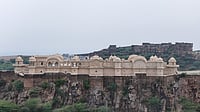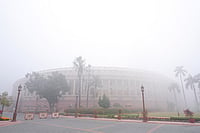
Public anger erupted in Nashik’s Tapovan after notices suggested about 1,700 trees could be cleared for a Sadhu Gram before the 2026–27 Kumbh Mela. This prompted large protests by residents, NGOs and activists.
Authorities claim only unavoidable trees will be removed. Locals say these assurances echo past unfulfilled promises.
Protesters say planners care more about finishing on time than about protecting nature. Now the fight is about development, religious politics, and whether the environment is really valued.
They came with garlands and slogans, but the protest in Nashik’s Tapovan was not staged. Last week, residents gathered beneath banyan and tamarind trees along the Godavari’s banks. The cause was a municipal notice: land in Tapovan, set aside for temporary accommodation for visiting saints at the 2026–27 Kumbh Mela, could be cleared. Reports said about 1,700 trees might be cut. The scale and method of the plan sparked public anger.
A city’s ritual calendar, layers of bureaucracy, and the slow life of a tree intersect. The Nashik-Trimbakeshwar Kumbh Mela Authority and municipal corporation are preparing for an event that lasts months and draws millions. This requires massive logistics, including a Sadhu Gram for sadhus and Vaishnava religious orders. Officials claim the project will balance mela infrastructure with ecology. Older trees will be retained where possible. Saplings will be planted at a 10:1 ratio. Only trees that are impossible to transplant will be removed after assessment.
For those who live in Nashik, and for the environmental groups who have watched this city mature against the Godavari’s flows, the official line reads like a rerun of past promises. “Very-old trees have been marked,” said Roshan Kedar, a local activist. He pointed out that previous editions of the Kumbh were able to accommodate pilgrims without razing the riverside’s established canopy. Hundreds of objections were filed with the municipal roll. More than 600 responses were recorded to the NMC’s notice, prompting authorities to call a hearing. Protestors—a cross-section of students, homemakers, farmers, and retired teachers—argued that mature trees are not replaceable public goods. They are living pieces of memory and microclimate that a plantation drive cannot simply substitute.
The familiar drama of public protests and celebrity appearances arrived quickly. Popular Marathi actor Sayaji Shinde, known for planting trees in western Maharashtra, and now active in a regional political group, joined the protesters, saying no tree would be cut. His support focused public anger and spread it beyond petitions into the media and politics. For many locals, actors and activists turned a civic complaint into a symbolic stand. If a public tree falls, what else can be lost in the name of ritual infrastructure?
Beneath the headlines is not just a dispute about square meters. It is a collision of timelines. Trees mature over generations. Municipal planning works to electoral cycles and event timetables.
Amidst the public uproar, it was said that only the required number of trees would be cut. “Trees that can be transplanted will be relocated elsewhere. Also, ten saplings will be planted and nurtured for every tree removed, assured,” Mahajan says.
The technical issues raised by both sides concern which tree species can actually survive transplanting. Officials have stated that some types of trees can be moved to new locations, while others—especially large, mature trees with deep taproots—usually cannot survive the process.
Kumbh Mela Minister Girish Mahajan has said transplantation and compensatory planting will be carried out. "We will not remove old trees… only those that affect our plans and cannot be transplanted," Mahajan said. He added that, for every tree removed, ten saplings would be planted.
Activists respond by pointing out that transplantation is not always successful, as survival rates after moving mature trees can vary, and the process does not guarantee full restoration of the lost canopy. It can take many years, or even decades, for new saplings to grow enough to provide the same environmental benefits as mature trees. Activists also argue that social and heritage values attached to old trees cannot be easily measured or replaced by compensation metrics.
On the ground, the protest has a mundane choreography. Residents meet at the marked trees. Local NGOs file objections. Social media posts amplify images of “heritage” trees. The municipal roll-call of objections precedes a formal hearing. Legal recourse remains possible. Environmental groups are weighing petitions. Civic activists are preparing case studies on the viability of transplantation and on precedents where large gatherings were hosted with minimal ecological damage.
In the end, the argument is not against the Kumbh. Nashik’s residents value the ritual and know it needs orderly hosting. Their demand is simple but strong: treat nature as a stakeholder, not something to remove. As Nashik prepares to host millions for months, the question is whether sacred events can take place without harming the slow growth of its trees



























